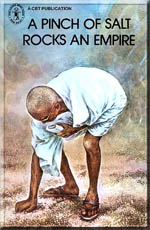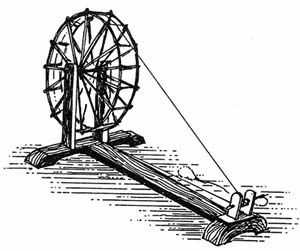
P.O. SEVAGRAM, DIST.WARDHA 442102, MS, INDIA. Phone: 91-7152-284753
FOUNDED BY MAHATMA GANDHI IN 1936
A Pinch of Salt Rocks An Empire
Children's Book : on Dandi March - Salt March

A PINCH OF SALT ROCKS AN EMPIRE
Compiled & Edited by : Sarojini Sinha
Table of Contents
- Map of March Route
- Chapter-1
- Chapter-2
- Chapter-3
- Chapter-4
- Chapter-5
- Chapter-6
- Chapter-7
- Chapter-8
- Chapter-9
- Chapter-10
- Chapter-11
- Chapter-12
- Chapter-13
About This Book
Compiled & Edited by : Sarojini Sinha
Illustration by : : Mrinal Mitra
First Published :1985
I.S.B.N :81-7011-291-5
Published by :Children's Book Trust
Printed at : Indraprastha Press
Nehru House,
4 Bahadur Shah Zafar Marg,
New Delhi,
India
Navajivan Mudranalaya,
Ahemadabad-380014
India.
© CBT, 1985
Download
Chapter - 8

More and more people were arrested as the movement spread. Soon almost a lakhs of people were in jail.
And the government began to turn brutal. It became common for three or four policemen to pounce on a single
satyagrahi and twist his wrist and thumb or throw him on the ground and trample on him till he bled, to make him surrender the salt in his possession.
An eye-witness gave this account of the Salt Satyagraha in a village in the Balasore district of Orissa: "When volunteers were bringing 'salt-earth' to make salt, policemen fell on them and started beating and kicking them. Their patient suffering drew tears from the eyes of spectators. At last, tired of beating and kicking them, the policemen stood beside the volunteers as they made a pile of the "salt-earth" and kicked and leveled the pile. In spite of this, the volunteers worked from early morning to noon and again from three to six in the afternoon. Many succeeded in taking the 'salt-earth' to their camp and made salt from it. This salt was publicly sold in Balasore town."
The police then tried to prevent the volunteers from collecting 'salt-earth' by seizing them by the arms. But they could not restrain all of them and salt was again made and sold in Balasore.
Meanwhile, people from nearby villages started making salt. The authorities knew of it but could not do much, with thousands of people flouting authority. They followed the policy of arresting those who appeared to be the leaders, but that did not deter the people.
The villagers retaliated by boycotting government servants. No official could buy any article in the village. Everything had to be brought from Balasore.
This kind of social boycott of government servants took place all over India and caused great hardship to them.
There were reports of brutality by policemen everywhere. In Delhi, it was reported: "Ten
satyagrahis were injured, five of them seriously, as the police tried to wrest a bucket of salt from their hands."
From Bihar, Rajendra Prasad, who was later to be the first President of independent India, gave this report:
"According to our plan the first batch of five volunteers went in the morning and when they were walking along the road they were overtaken by a body of
sowars under the command of an European officer. Three of them were mercilessly beaten by the European officer and thrown into the drain from where they were removed by our stretcher bearers.
"A second batch of volunteers was sent, but they too were beaten. In the evening, a third batch of five volunteers was sent. They were challenged by the police who tried to snatch away the flags they had in their hands. The two European officers used their batons on the leaders. There was no retaliation or fight by the people."
When thousands of people set out from Patna to go to a spot where salt could be made, police blocked the highway. The crowd stayed and slept on the road and the surrounding fields for forty hours.
After Rajendra Prasad, who was leading them, had refused to ask the crowd to disperse, a charge by mounted police was ordered. As the horses galloped forward, men and women threw themselves on the ground. The horses reared and stopped. They would not trample them. Then the constables lifted those lying on the ground and took them to jail. But other demonstrators took their place.
At Ludhiana, in Punjab, fifty men were injured in a police lathi charge.
At Peshawar, in the North-West Frontier Province, which is now a part of Pakistan, two armoured cars full of soldiers were driven into a crowd returning from a meeting. Many people were run over and injured and at least three were killed on the spot. In spite of this, the crowd continued to be peaceful. As they were collecting the dead and injured, an English officer on a motorcycle who dashed into the crowd was killed when he collided with one of the armoured cars.
More English soldiers had by then reached the place, and, without warning, started firing into the crowd in which there were women and children.
The people gave a good demonstration of the lesson of non-violence they had learnt. When those in front fell, those behind came forward to expose themselves to the firing. Soon there were heaps of dead and wounded. The firing continued from eleven in the morning till five in the evening. But not one broke ranks or fled. When the bodies were collected, it was found that not a single demonstrator had bullets in the back. Not one made a hostile move. Even the police admitted that the crowd was perfectly peaceful throughout. In no battle was greater courage ever shown. Gandhiji had inspired them.
Another noteworthy feature of the movement was the way in which women took part in it. Gandhiji had always insisted on treating women as equals and on removing their disabilities. Now they came forward to take part in the demonstrations and picketing of shops selling foreign cloth or liquor. The government was taken aback.
The movement launched by Gandhiji had proved successful. Pandit Jawaharlal Nehru wrote, "It was as though a spring had been suddenly released. We marveled at the amazing knack of the man to impress the multitude and make it act in an organized manner."